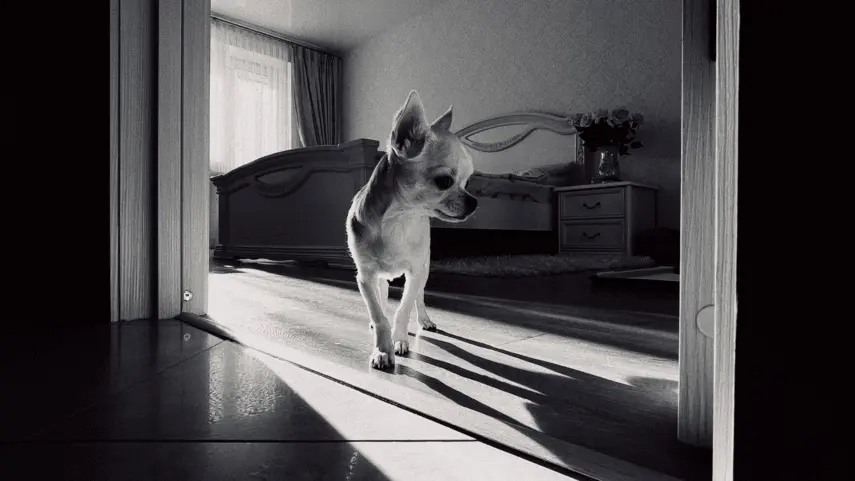Why Does My Dog Walk Backwards? 5 Possible Reasons
Why does my dog walk backwards? Uncover the mysterious behavior of dogs walking backwards and discover the possible reasons behind it.
Dogs can strut, pace, hop, or jump their way around. But why does my dog walk backwards sometimes. Dogs walking backwards can be a perplexing behavior for pet owners to witness. While it may seem unusual, there can be various reasons behind this behavior.

Understanding why dogs walk backwards can help provide insights into their overall well-being and address any underlying issues. Below, I discuss the possibilities as to why your dog has started to walk backward. When in doubt, you should consult a veterinarian for professional advice.
Why does my dog walk backwards?

If your dog is walking backward all of a sudden, the following reasons may explain why:
1. You reinforced the behavior.
A possible reason why dogs walk backwards is that they were trained or encouraged to do so. It’s possible that your pet did it before and it solicited a reaction. Over time, your canine will realize that walking backward gets your attention. The pooch may do it repeatedly to please you or trigger any form of reaction.
If you introduced this behavior to your dog, there’s nothing to worry about. If you are worried about it, you can work with a professional dog trainer or behaviorist to identify the root cause of the behavior and develop a training plan to address it.
2. Your dog is afraid.
Fear or anxiety can be another possible reason for dogs walking backwards. Some dogs may exhibit this behavior when they feel threatened, scared, or uncomfortable in certain situations. It can be a response to a specific trigger or a general manifestation of their anxiety. Walking backward with a tucked tail is a sign that your dog is scared.
Identifying the source of fear or anxiety is crucial in addressing this behavior. Professional guidance from a dog trainer or behaviorist can help develop a behavior modification plan that focuses on desensitization and counterconditioning techniques. Creating positive associations and gradually exposing the dog to the triggering stimuli can help reduce their distress and minimize the likelihood of walking backwards.
3. Your dog is injured.
Injuries sustained while running or falling from a high surface can cause backward walking in dogs. It’s possible that by walking this way, the pooch can remove the pressure from the part that aches. You may also notice your pet limping and whimpering whenever it tries to walk. Some dogs will be reluctant to move in general.
It’s important to get your dog checked if it’s walking backward and in pain. This way, the injury won’t worsen and it will be treated right away.
4. Your dog has age-related issues
Aside from that, senior dogs that suffer from arthritis are more prone to exhibit this behavior. If their front leg joints hurt, the old dog will start to walk backward to ease the pain.
For old dogs with arthritis, life-long care to manage the symptoms is the best course of action. Once your dog is free of the pain, it will start to walk normally again.
Age-related changes can contribute to dogs walking backwards. As dogs get older, they may experience cognitive decline, mobility issues, or physical limitations that affect their ability to walk normally. These changes can result in unusual behaviors, including walking backwards.
Providing appropriate care and accommodations for senior dogs is essential to manage age-related changes. Regular veterinary check-ups, a balanced diet, and exercise tailored to their abilities can help improve their overall well-being. Additionally, providing a safe and comfortable environment that minimizes obstacles and promotes easy movement can make a significant difference in their quality of life.
5. Your dog has a physical or neurological medical condition
One possible reason for dogs walking backwards is the presence of underlying medical conditions. Dogs experiencing neurological problems, musculoskeletal disorders, or any other health issues that affect their coordination and balance may exhibit this behavior. If you notice your dog walking backwards, it is essential to consult with a veterinarian to rule out any potential medical causes. They can perform necessary tests and examinations to determine the underlying condition and provide appropriate treatment.
Some common medical conditions that can contribute to dogs walking backwards include vestibular disease, spinal cord injuries, arthritis, hip dysplasia, and certain types of tumors. Each condition requires specific medical interventions, and early diagnosis is crucial for successful management. By addressing the medical cause, you can help improve your dog’s overall well-being and prevent any further complications.
Why does my dog walk backwards due to some of these medical conditions? Here are some explanations:
- Seizures. During a seizure, an epileptic dog may appear as if it’s walking backward before falling to the ground. Overall, a canine may exhibit various movements during a seizure.
- Spinal cord diseases. Problems with the spinal cord can also cause uncontrollable backward walking in canines. This can affect dogs of any age and breed.
- Cognitive decline. General cognitive decline in older dogs can result in different behaviors. Affected dogs may start to walk backward, wobble, have poor coordination, and more. This condition is often progressive and considered typical of an old canine.
Frequently Asked Questions
Why does my dog walk backwards through doors?

Dogs may walk backward through doors to keep their eye on whoever is behind them. This can be a sign of trauma, especially for rescued canines. Your pooch does this to ensure that whatever is on the other side of the door won’t hurt them. It can be a person, an object, or another animal.
Aside from physical abuse, dogs may also walk backward on doors during storms and loud noises. And if your dog had an unpleasant experience with one of your doors, they may specifically walk backward on it.
Why does my dog walk backwards when I’m reaching out to pet him?
Fear is the main reason why dogs would move backward when you try to pet them. It’s possible that the canine had a negative experience with such a gesture before. This is much so if the person trying to pet the dog is a stranger. Take note that dogs don’t have the same level of friendliness toward new people they meet.
Instead of trying to pet the dog, let the pooch get near you at its own pace. Pet only when the dog is relaxed around your presence.
Why does my dog walk like he’s drunk?
Drunk walking can be due to a condition in dogs called vestibular ataxia. This happens when the canine suffered from ear infections, tumors, hypothyroidism, damaged eardrum, and more.
Aside from wobbling, ataxia can also trigger head tilting, widespread legs while standing, and rapid eye movement even when awake. Dogs with this condition will also prefer to sleep on hard surfaces since it’s more stable.
The good news is that vestibular ataxia is rarely life-threatening. It can clear up on its own in a matter of weeks. However, idiopathic ataxia may not go away. Since the cause is unknown, there’s little a veterinarian can do to treat the condition.
Why is my dog walk weirdly on his back legs?
A dog walking weirdly on its back legs might be dealing with hip dysplasia. This condition causes the hip joint to disengage, which will lead to walking and posture problems.
Aside from that, nerve damage and muscle atrophy can also be to blame. It’s important to have your dog examined to diagnose the real cause of its unusual walking appearance.
Conclusion
Why does my dog walk backwards? It can be due to fear, joint pain, injury, hip dysplasia, or a neurological condition. If it’s not going away, you should consult a veterinarian. This way, your dog will receive treatment if need be.
